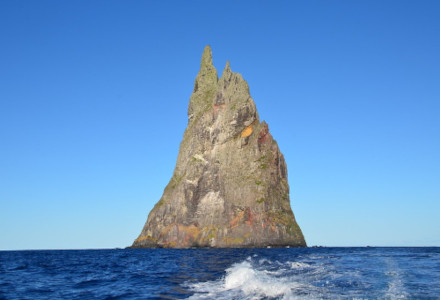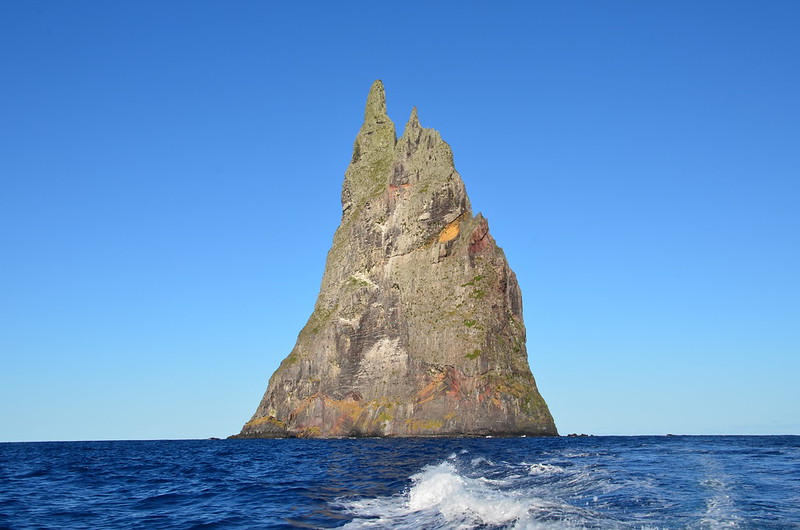Ball’s Pyramid Facts
- This astounding geological formation, jutting magnificently up from beneath the surface of the ocean, bears the simple name of Ball’s Pyramid. This breathtaking landform further holds a place of honor among the similar one’s around the world.
- That holds true because the site ranks as the tallest formation of its kind known to man. The local government accorded it a special place in their culture, due to this fact. The site now forms part of a protected area named the Lord Howe Island Marine Park.
- Presently, it’s unknown if ancient mariners ever glimpsed this masterpiece of natural processes. The first recorded sighting of it took place 1788. Its name pays homage to the first known person to spot it, Lieutenant Henry Lidgbird Ball, who made that sighting.
- This marvelous work of geological forces also shares a common fact with yet another remarkable landform. That’s because the intrepid officer also, for the first time in recorded history, discovered the fascinating formation known as Lord Howe Island.
- Geologist Henry Wilkinson became the first known person to step foot onto Ball’s Pyramid, in 1882. Multiple attempts to scale its heights failed, until one finally succeeded in 1965. Several other attempts to climb it followed in the ensuing years.
- In 1982, however, the government of the region banned all such attempts. Then, in 1986, the government banned all access to the site. But, in 1990, the leaders relaxed that restriction, to allow limited attempts. Doing so now requires an official permit.
Related Articles
Ball’s Pyramid Physical Description
Certainly, the stark yet stunning Ball’s Pyramid, of a type known as a stack, merits appreciation. It does so, however, due to a combination of several statistics. The combination of these makes for a remarkable, not to mention, hard to believe, recounting.
For starters, the site juts sharply up from the sea, standing a respectable 1,844 ft (562 m) tall. Yet that alone doesn’t serve to distinguish it from countless other sites around the world. Indeed, countless others reach far greater heights, relative to the surrounding waters.
It stands out, however, due to the sheer steepness of its slopes. At the point where it meets the water, it measures a mere 3,609 ft (1,100 m) in length. Its width, though, only reaches a scant 984 ft (300 m) across at its widest point at any spot along its length.
Those measurements lend the awe-inspiring monolith of Ball’s Pyramid a sharply triangular shape. Its steep sides also possess very few breaks or ledges to mar the otherwise relatively smooth surface. The combination creates a starkly beautiful, if mostly vertical, landscape.
Ball’s Pyramid Location, Formation, and Ecology
Part of the reason why the incredible Ball’s Pyramid wasn’t discovered, to our knowledge, at least, until the 18th century, occurs due to its location. That’s because it formed in a comparatively remote part of the ocean, situated in the Southern Hemisphere.
More precisely, though, this marvel of Nature lies roughly 12 mi (20 km) from Lord Howe Island. That further places it approximately 400 mi (643.7 km) northeast of Sydney, Australia. The island, and the local region, presently constitutes a possession of that country.
To no great surprise for those who understand geology, the site also has a volcanic origin. Specifically, it represents an erosional remnant, due to the actions of the surrounding waves. It originally formed part of the caldera of what’s known as a shield volcano.
Evidence uncovered by researchers indicates that the original volcano formed sometime around 6.4 million years ago. The site, furthermore, actually forms part of the submerged continent named Zealandia. It’s now positioned roughly in the center of a submarine shelf.
Given the local conditions, very little life inhabits the magnificent Ball’s Pyramid. Yet, the resourcefulness of Nature cannot be overlooked. Scant vegetation clings to the rocks there, however, struggling to surive in the harsh and inhospitable environment.
That vegetation mostly consists of a very small variety of grasses, mosses, and lichens. A limited population of small shrubs also appear, eking out their survival. These mainly consist of a species in the Myrtle family, endemic to the surrounding region.
Occasionally, however, a few seabirds make their nests on the site. Several locally numerous species make use of its special geography for their purposes. That’s due to the understandable fact that the steep walls provide a refuge for the raising of the young.
Astonishingly, though, a single species of insect makes its home there. That’s because a tiny population of the awesome Lord Howe Island Stick Insect lives there. The entire known population, however, consists of only a few dozen specimens, living under a single bush!
Species Sharing Its Region
Check out our other articles on 3 Bewildering New Guinea Birds, Chinese Giant Salamander, Namib Desert, Dwarf Crested Iris, California red-sided garter snake, Southern Tamandua


